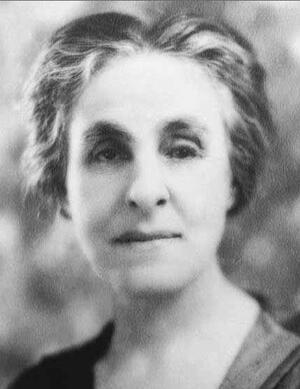Icons for the New Year: Ray Frank
While seeking stories of transformation this holiday season, most of the tales that have caught my attention involved women who exchanged quiet domestic lives for active involvement in the public sphere. Ray Frank did the opposite: she swapped her life as a trailblazing Jewish leader for one away from the spotlight.
Ray Frank, “the Girl Rabbi of the Golden West,” was born to Polish immigrants in 1861 in San Francisco. She taught bible studies and Jewish history while writing for various local newspapers and Jewish publications. Then in 1890, Frank was invited to deliver a sermon for Rosh Hashanah—a momentous event for Frank and for women in California’s burgeoning Jewish community. She spent much of the next decade lecturing and giving sermons, and her work sparked important conversations about the ordination of women in the U.S.
Despite her progressive career, Frank was a complicated woman whose self-stated beliefs were often at odds with her actions. She claimed to be a staunch opponent of the Women’s Rights movement and even spoke out against women’s suffrage. And, despite being (mis-) identified as “the first women rabbi” in countless headlines, Frank publicly opposed women becoming rabbis.
In 1901, Ray Frank got married. Despite financially supporting herself for over a decade, she did not believe that married women should work outside of the home and effectively ended her career after her wedding. Looking back, such a dramatic choice feels like a step backward. In reality, it was just a step in another direction: though she traded recognition and acclaim for a more ordinary life in Illinois, Frank began mentoring small groups of Jewish students in her local community and served as president of the Sinai Temple Sisterhood for 15 years. Later in life, Frank seems to have changed her feelings about suffrage: she helped to form the Champaign County League of Women Voters.
Ray Frank’s story doesn’t appeal to modern feminist sensibilities, and it’s temping to ignore the second half of her life in order to squeeze her into a more liberal mold. But does Frank’s decision to retire from public life and adopt a traditional home life make her less impressive? It must have taken a great deal of strength to be the first woman to speak at all of those synagogues; was publicly changing the course of her life and leaving her career any less difficult? Ray Frank’s story is a testament to taking control of our lives and making our own decisions, regardless of their popularity. Not a bad lesson to carry with us into the new year.







I am building a Bridge Coalition of Oakland and San Francisco to end Homelessness in America, and Ray Frank was picked by Anodai to be the rally person to represent a continued Jewish movement of innovators and tactician service providers . Sister Ray Frank is that wonderful Jewish Messianic Leader who knew that Judaism would need to tear down the " fence" in a future time but not her own . Such " Rebecca " type wisdom showed she was correct in her posture and grace !